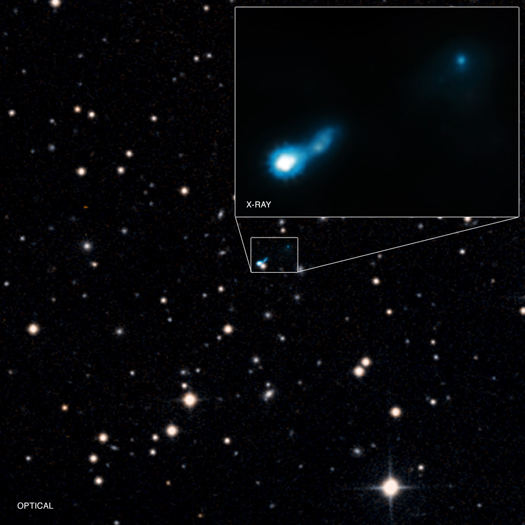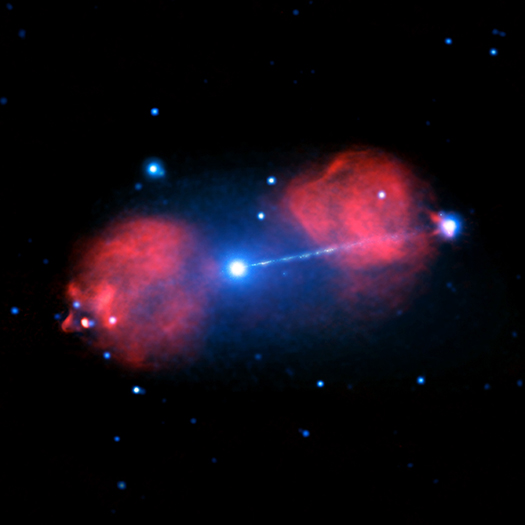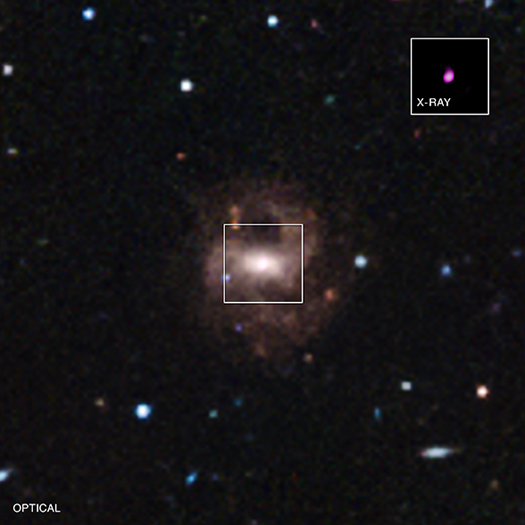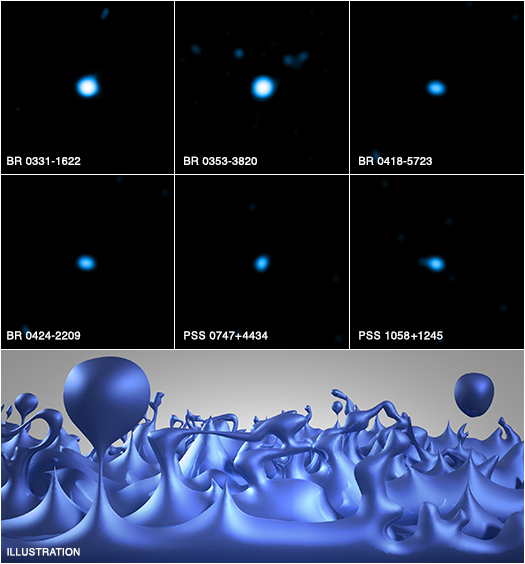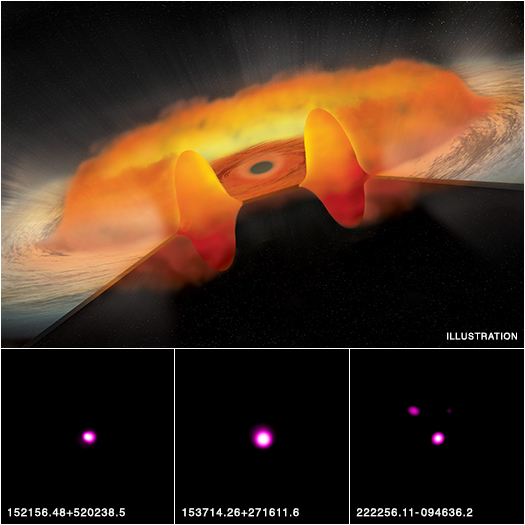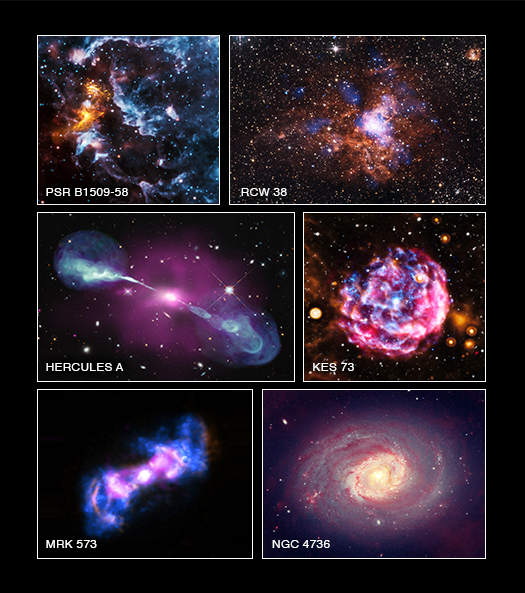Quasars & Active Galaxies
Surprise Discovery of X-ray Bright Supermassive Black Hole Jet in the Early Universe

Aurora Simionescu
We are pleased to welcome a guest blogger, Aurora Simionescu, who led the study that is the subject of our latest press release, about a distant X-ray jet. Originally from Romania, Aurora completed her PhD at the Max Planck Institute for Extraterrestrial Physics in Garching, Germany, before moving to Stanford University as an Einstein Postdoctoral Research Fellow. She is currently working as an International Top Young Fellow at the Institute of Space and Astronautical Sciences of the Japan Aerospace Exploration Agency. Besides being a high-energy astrophysicist, she is also a part-time travel and nature photographer with a skiing addiction who loves ballroom dancing and the color pink.
Around March 2014, my colleague, Lukasz Stawarz, who was then sharing an office with me at the Japan Aerospace Exploration Agency, showed me a very odd astronomical object he and his collaborators had found by searching though archived radio observations from the Very Large Array (VLA).
Glow from the Big Bang Allows Discovery of Distant Black Hole Jet
A jet from a very distant black hole being illuminated by the leftover glow from the Big Bang, known as the cosmic microwave background (CMB), has been found as described in our latest press release. Astronomers using NASA's Chandra X-ray Observatory discovered this faraway jet serendipitously when looking at another source in Chandra's field of view.
Blast from Black Hole in a Galaxy Far, Far Away
The Star Wars franchise has featured the fictitious "Death Star," which can shoot powerful beams of radiation across space. The Universe, however, produces phenomena that often surpass what science fiction can conjure.
The Pictor A galaxy is one such impressive object. This galaxy, located nearly 500 million light years from Earth, contains a supermassive black hole at its center. A huge amount of gravitational energy is released as material swirls towards the event horizon, the point of no return for infalling material. This energy produces an enormous beam, or jet, of particles traveling at nearly the speed of light into intergalactic space.
The Hunt for the Smallest Supermassive Black Holes

Vivienne Baldassare
We are very pleased to welcome Vivienne Baldassare as a guest blogger today. Vivienne is the first author of a paper that is the subject of our latest press release, about an exceptionally small supermassive black hole. She is a PhD candidate and National Science Foundation Graduate Research Fellow in the University of Michigan Department of Astronomy. Vivienne obtained her undergraduate degree in physics from Hunter College, where she was also a member of the Macaulay Honors College.
It is well established that most, if not all, massive galaxies host supermassive black holes at their centers − our own Milky Way houses a several million solar mass black hole in its core. Little is known, however, about the population of black holes in the centers of dwarf galaxies. I study the centers of small galaxies to see how many host supermassive black holes and if those black holes interact with their galaxies in the same way as bigger supermassive black holes.
Though dwarf galaxies are more common than large galaxies, it is more difficult to determine whether they host black holes. When galaxies are large and nearby, we can find central black holes by studying the motions of stars in the region dominated by the gravity of the black hole. Since smaller black holes influence smaller regions, this method would only work for dwarf galaxies in our cosmological back yard. Instead, we must search for active black holes in dwarf galaxies, i.e. black holes that are voraciously consuming material, releasing large amounts of light from the galaxy’s center.
Oxymoronic Black Hole Provides Clues to Growth
Astronomers using NASA's Chandra X-ray Observatory and the 6.5-meter Clay Telescope in Chile have identified the smallest supermassive black hole ever detected in the center of a galaxy, as described in our latest press release. This oxymoronic object could provide clues to how much larger black holes formed along with their host galaxies 13 billion years or more in the past.
The Great and the Small: Is Quantum Foam Losing its Fizz?

Eric Perlman
We are very pleased to welcome Eric Perlman as a guest blogger today. He led the study setting limits on the foaminess of space-time that is the subject of our latest press release. Eric is a professor at the Florida Institute of Technology. After completing his PhD in 1994 at the University of Colorado, he held postdoctoral fellowships at the Goddard Space Flight Center and Space Telescope Science Institute. He also held research positions at Johns Hopkins University and the University of Maryland, Baltimore County. He has lived in Florida for 8 years and enjoys his family, singing, and playing chess and other board games.
Astronomy has been a tool of discovery since the dawn of civilization. For thousands of years, humans used the stars to navigate and find their place in the universe. Astronomy made possible the travels of the ancient Polynesians across the Pacific Ocean as well as measurements of the Earth’s size and shape by the ancient Greeks. Today, astronomers search for hints about what the universe was like when the universe was much younger. So imagine, for a second, what life would be like – and how much less we would know about ourselves and the universe – if the microscopic nature of space-time made some of these measurements impossible.
NASA Telescopes Set Limits on Space-time Quantum Foam
A new study combining data from NASA's Chandra X-ray Observatory and Fermi Gamma-ray Telescope, and the Very Energetic Radiation Imaging Telescope Array (VERITAS) in Arizona is helping scientists set limits on the quantum nature of space-time on extremely tiny scales, as explained in our latest press release.
Certain aspects of quantum mechanics predict that space-time - the three dimensions of space plus time -- would not be smooth on the scale of about ten times a billionth of a trillionth of the diameter of a hydrogen atom's nucleus. They refer to the structure that may exist at this extremely small size as "space-time foam." This artist's illustration depicts how the foamy structure of space-time may appear, showing tiny bubbles quadrillions of times smaller than the nucleus of an atom that are constantly fluctuating and last for only infinitesimal fractions of a second.
Supermassive Black Holes Running at Full Tilt

Bin Luo
We are very pleased to welcome Bin Luo as a guest blogger today. He led the study on supermassive black holes that is the subject of our latest press release. Bin obtained a PhD degree in Astronomy and Astrophysics from the Pennsylvania State University in 2010, working on the Chandra Deep Field surveys. He then worked as a postdoctoral fellow at the Harvard-Smithsonian Center for Astrophysics, and later back at the Pennsylvania State University. He will start a faculty position in September 2015 at the Nanjing University in China. Bin has mainly been working on X-ray studies of supermassive black holes in the centers of galaxies. He is now leading the data analysis of the 7-million-second (81 days) Chandra Deep Field-South survey, the deepest Chandra observation ever performed.
I have been studying the X-ray emission from accreting supermassive black holes since I was a graduate student. These monstrous black holes – quasars fueled by large amounts of gas and dust, consuming of the order of a couple solar masses per year – are known nearly universally to be strong X-ray emitters. Meanwhile, strong line emission – that is, light coming from a narrow range of wavelengths – is also a hallmark of quasar spectra in optical and ultraviolet bands. Therefore, I was quite puzzled when we discovered that a small group of quasars with remarkably weak ultraviolet line emission are often extremely X-ray weak. The pioneering work was led by Jianfeng Wu, Niel Brandt, and Pat Hall in 2011 and 2012, where the X-ray emission from 19 such quasars was examined. What makes things even more interesting is that for a subgroup of these quasars selected with refined ultraviolet properties, almost 100% are weak in X-ray light.
NASA's Chandra Suggests Black Holes Gorging at Excessive Rates
Astronomers have studied 51 quasars with NASA's Chandra X-ray Observatory and found they may represent an unusual population of black holes that consume excessive amounts of matter, as described in our latest press release. Quasars are objects that have supermassive black holes that also shine very brightly in different types of light. By examining the X-ray properties with Chandra, and combining them with data from ultraviolet and visible light observations, scientists are trying to determine exactly how these large black holes grow so quickly in the early Universe.
Our Universe in Color
Today we released six new images from Chandra’s vast data archive. Each one of these astronomical images combines X-rays from Chandra with data from telescopes that detect different types of light such as infrared, radio, and visible light.

